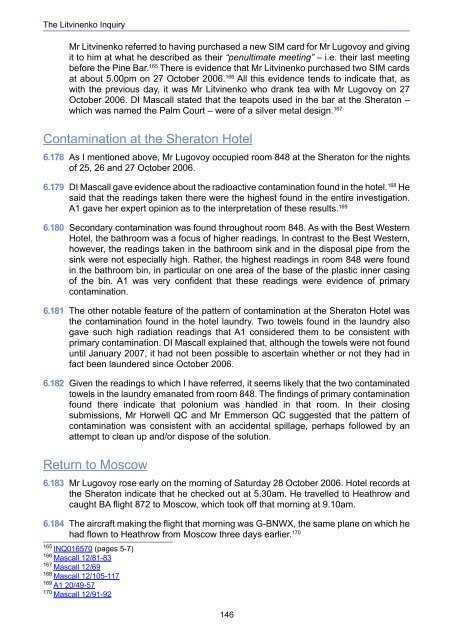The Litvinenko Inquiry
2429870
2429870
Create successful ePaper yourself
Turn your PDF publications into a flip-book with our unique Google optimized e-Paper software.
<strong>The</strong> <strong>Litvinenko</strong> <strong>Inquiry</strong><br />
Mr <strong>Litvinenko</strong> referred to having purchased a new SIM card for Mr Lugovoy and giving<br />
it to him at what he described as their “penultimate meeting” – i.e. their last meeting<br />
before the Pine Bar. 165 <strong>The</strong>re is evidence that Mr <strong>Litvinenko</strong> purchased two SIM cards<br />
at about 5.00pm on 27 October 2006. 166 All this evidence tends to indicate that, as<br />
with the previous day, it was Mr <strong>Litvinenko</strong> who drank tea with Mr Lugovoy on 27<br />
October 2006. DI Mascall stated that the teapots used in the bar at the Sheraton –<br />
which was named the Palm Court – were of a silver metal design. 167<br />
Contamination at the Sheraton Hotel<br />
6.178 As I mentioned above, Mr Lugovoy occupied room 848 at the Sheraton for the nights<br />
of 25, 26 and 27 October 2006.<br />
6.179 DI Mascall gave evidence about the radioactive contamination found in the hotel. 168 He<br />
said that the readings taken there were the highest found in the entire investigation.<br />
A1 gave her expert opinion as to the interpretation of these results. 169<br />
6.180 Secondary contamination was found throughout room 848. As with the Best Western<br />
Hotel, the bathroom was a focus of higher readings. In contrast to the Best Western,<br />
however, the readings taken in the bathroom sink and in the disposal pipe from the<br />
sink were not especially high. Rather, the highest readings in room 848 were found<br />
in the bathroom bin, in particular on one area of the base of the plastic inner casing<br />
of the bin. A1 was very confident that these readings were evidence of primary<br />
contamination.<br />
6.181 <strong>The</strong> other notable feature of the pattern of contamination at the Sheraton Hotel was<br />
the contamination found in the hotel laundry. Two towels found in the laundry also<br />
gave such high radiation readings that A1 considered them to be consistent with<br />
primary contamination. DI Mascall explained that, although the towels were not found<br />
until January 2007, it had not been possible to ascertain whether or not they had in<br />
fact been laundered since October 2006.<br />
6.182 Given the readings to which I have referred, it seems likely that the two contaminated<br />
towels in the laundry emanated from room 848. <strong>The</strong> findings of primary contamination<br />
found there indicate that polonium was handled in that room. In their closing<br />
submissions, Mr Horwell QC and Mr Emmerson QC suggested that the pattern of<br />
contamination was consistent with an accidental spillage, perhaps followed by an<br />
attempt to clean up and/or dispose of the solution.<br />
Return to Moscow<br />
6.183 Mr Lugovoy rose early on the morning of Saturday 28 October 2006. Hotel records at<br />
the Sheraton indicate that he checked out at 5.30am. He travelled to Heathrow and<br />
caught BA flight 872 to Moscow, which took off that morning at 9.10am.<br />
6.184 <strong>The</strong> aircraft making the flight that morning was G-BNWX, the same plane on which he<br />
had flown to Heathrow from Moscow three days earlier. 170<br />
165<br />
INQ016570 (pages 5-7)<br />
166<br />
Mascall 12/81-83<br />
167<br />
Mascall 12/69<br />
168<br />
Mascall 12/105-117<br />
169<br />
A1 20/49-57<br />
170<br />
Mascall 12/91-92<br />
146


